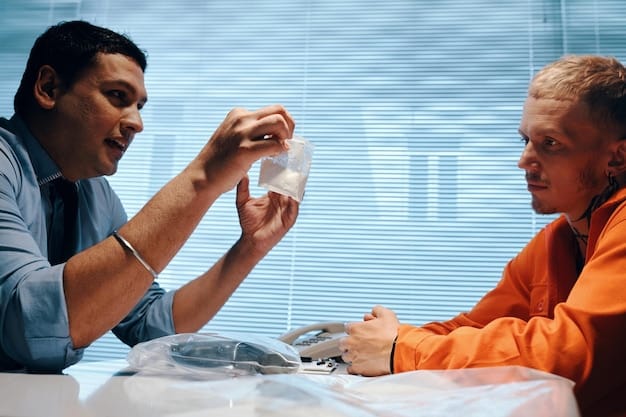Latest Research on Medication-Assisted Treatment (MAT) for Opioid Addiction

Recent research highlights the effectiveness of Medication-Assisted Treatment (MAT) in combating opioid addiction, showing significant improvements in patient outcomes through integrated approaches combining medication with counseling and behavioral therapies.
Opioid addiction remains a significant public health crisis in the United States, but advancements in treatment strategies offer hope for recovery. This article delves into what are the latest research findings on Medication-Assisted Treatment (MAT) for opioid addiction, exploring how these findings are shaping the landscape of addiction recovery.
Understanding Medication-Assisted Treatment (MAT)
Medication-Assisted Treatment (MAT) is an evidence-based approach that combines behavioral therapy and medications to treat substance use disorders, including opioid addiction. This comprehensive strategy aims to address both the physical and psychological aspects of addiction, offering a more holistic path to recovery.
The Core Components of MAT
MAT integrates FDA-approved medications with counseling and behavioral therapies. The medications help to normalize brain function, relieve cravings, and block the euphoric effects of opioids, making it easier for individuals to focus on therapy and recovery.
Why MAT is Considered a Gold Standard
MAT is often considered the gold standard in addiction treatment due to its proven efficacy in reducing opioid use, preventing overdose deaths, and improving overall patient outcomes. It’s a flexible approach that can be tailored to meet the unique needs of each individual, making it a versatile option for various patient populations.
- Reduces opioid cravings and withdrawal symptoms.
- Blocks the euphoric effects of opioids, discouraging relapse.
- Improves adherence to treatment through medication management.
- Enhances the effectiveness of counseling and behavioral therapies.
In conclusion, Medication-Assisted Treatment stands out as a robust, evidence-backed strategy that blends pharmacological solutions with behavioral interventions. It is not merely a treatment but a comprehensive recovery program tailored to individual needs, thus playing a crucial role in combating opioid addiction and improving patient outcomes.
Recent Advances in MAT Medications
Recent years have seen significant advancements in the medications used in MAT, offering more options and improved outcomes for individuals battling opioid addiction. These advancements include new formulations, better understanding of medication interactions, and personalized approaches to medication selection.

Extended-Release Formulations
Extended-release formulations of medications like buprenorphine and naltrexone have been developed to provide longer-lasting effects, reducing the need for frequent dosing and improving adherence to treatment. These formulations can be administered as injections or implants, offering convenience and stability in medication delivery.
Naltrexone Implants
Naltrexone implants are a relatively new option that provides continuous release of naltrexone over several months. This eliminates the need for daily pills and ensures consistent medication levels, making it an attractive option for individuals who struggle with adherence or prefer a more discreet treatment method.
- Extended-release buprenorphine reduces the frequency of dosing.
- Naltrexone implants offer sustained medication levels for several months.
- Improved adherence leads to better treatment outcomes.
- Personalized approaches allow for tailored medication selection.
In summation, advancements in MAT medications have led to more effective and convenient treatment options for opioid addiction. The development of extended-release formulations and implants offers new hope for individuals seeking long-term recovery.
The Role of Behavioral Therapies in MAT
While medications play a crucial role in MAT, behavioral therapies are equally important for addressing the psychological and social factors that contribute to addiction. Integrating these therapies with medication leads to more comprehensive and sustainable recovery.
Cognitive Behavioral Therapy (CBT)
Cognitive Behavioral Therapy (CBT) helps individuals identify and change negative thought patterns and behaviors associated with addiction. CBT techniques can be used to manage cravings, cope with triggers, and develop healthier coping strategies.
Contingency Management (CM)
Contingency Management (CM) involves providing tangible rewards for positive behaviors, such as staying abstinent from opioids. This approach can be highly effective in promoting behavior change and reinforcing motivation for recovery.

- CBT helps individuals change negative thought patterns.
- CM provides rewards for positive behaviors, such as abstinence.
- Motivational interviewing enhances a person’s readiness to change.
- Group therapy offers peer support and shared experiences.
In conclusion, behavioral therapies are integral to the success of MAT, offering individuals the psychological tools and support needed to achieve long-term recovery. By addressing both the physical and psychological aspects of addiction, MAT provides a comprehensive path to healing.
Integrating MAT with Mental Health Services
Many individuals with opioid addiction also struggle with co-occurring mental health disorders, such as depression, anxiety, and PTSD. Integrating MAT with mental health services is crucial for addressing these complex needs and improving overall treatment outcomes.
Addressing Co-occurring Disorders
Treating co-occurring disorders involves providing integrated care that addresses both the addiction and the mental health condition simultaneously. This may include medication management, therapy, and other supportive services tailored to the individual’s specific needs.
The Impact on Treatment Outcomes
Integrating MAT with mental health services can significantly improve treatment outcomes by addressing the underlying issues that contribute to addiction. This comprehensive approach leads to more sustainable recovery and improved quality of life.
In summary, integrating MAT with robust mental health support addresses the multifaceted challenges faced by individuals with opioid addiction, improving long-term recovery and overall well-being.
Overcoming Barriers to MAT Access
Despite the proven benefits of MAT, many individuals still face barriers to accessing this life-saving treatment. These barriers include stigma, lack of awareness, regulatory restrictions, and limited availability of services. Overcoming these challenges is essential for expanding access to MAT and reducing the impact of the opioid crisis.
Reducing Stigma
Reducing stigma involves educating the public about addiction as a chronic disease and promoting acceptance of MAT as a legitimate and effective treatment. This can be achieved through public awareness campaigns, community outreach, and advocacy efforts.
Expanding Treatment Availability
Expanding treatment availability requires increasing the number of MAT providers, improving access to medications, and addressing regulatory barriers that limit the use of MAT. This may involve training more healthcare professionals, expanding telehealth services, and streamlining the process for prescribing MAT medications.
- Educate the public about addiction as a disease.
- Increase the number of MAT providers and treatment centers.
- Improve access to MAT medications and support services.
- Address regulatory barriers that limit MAT access.
Ultimately, overcoming barriers to MAT access is critical for saving lives and reducing the devastating impact of the opioid crisis. By addressing stigma, improving treatment availability, and promoting evidence-based policies, we can ensure that more individuals have access to this life-saving treatment.
The Future of MAT Research
Ongoing research is continuously refining and expanding the scope of MAT, promising more effective and personalized approaches to addiction treatment. These future directions aim to address current limitations and improve long-term outcomes for individuals with opioid addiction.
Personalized Treatment Approaches
Future research is focused on developing personalized treatment approaches that take into account individual differences in genetics, brain function, and environmental factors. This may involve using biomarkers to predict treatment response and tailoring medication selection and therapy to the individual’s specific needs.
New Medications and Technologies
Researchers are exploring new medications and technologies that can enhance the effectiveness of MAT. This includes developing novel medications that target different aspects of addiction, as well as using digital health technologies to improve adherence and monitor patient progress.
In conclusion, the future of MAT research holds great promise for more effective and personalized approaches to addiction treatment. By continuing to invest in research and innovation, we can improve the lives of individuals with opioid addiction and reduce the burden of this devastating disease.
| Key Point | Brief Description |
|---|---|
| 💊 MAT Components | Combines medication with therapy. |
| ⏱️ Extended-Release | Improves patient adherence. |
| 🧠 CBT & CM | Addresses psychological factors. |
| 🤝 Integrated Care | Treats addiction and mental health. |
Frequently Asked Questions (FAQ)
▼
Medication-Assisted Treatment (MAT) combines behavioral therapy and medications to treat substance use disorders. It’s an evidence-based approach that addresses both the physical and psychological aspects of addiction.
▼
Common medications used in MAT include buprenorphine, naltrexone, and methadone. These medications help reduce cravings, block the effects of opioids, and manage withdrawal symptoms.
▼
Behavioral therapies, such as CBT and contingency management, provide individuals with coping strategies, help change negative thought patterns, and reinforce positive behaviors, complementing medication’s effects.
▼
Integrating MAT with mental health services addresses co-occurring disorders, such as depression and anxiety, leading to more comprehensive treatment and improved overall outcomes for individuals.
▼
Overcoming barriers involves reducing stigma through education, expanding the availability of MAT providers and treatment centers, and addressing regulatory restrictions that limit access to medications.
Conclusion
In conclusion, ongoing research continues to highlight the effectiveness of Medication-Assisted Treatment (MAT) in combating opioid addiction. The integration of advanced medications, behavioral therapies, and mental health services offers a comprehensive approach to recovery, yet overcoming barriers to access remains crucial for those in need.





